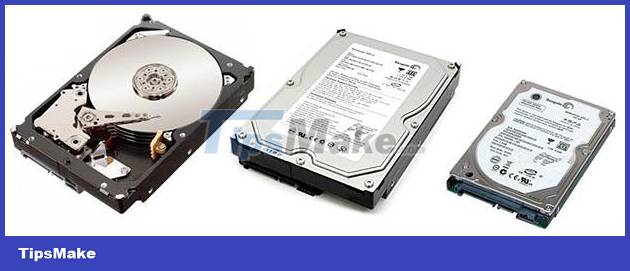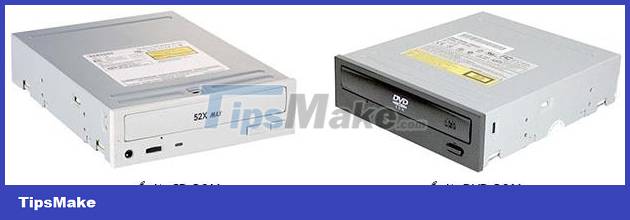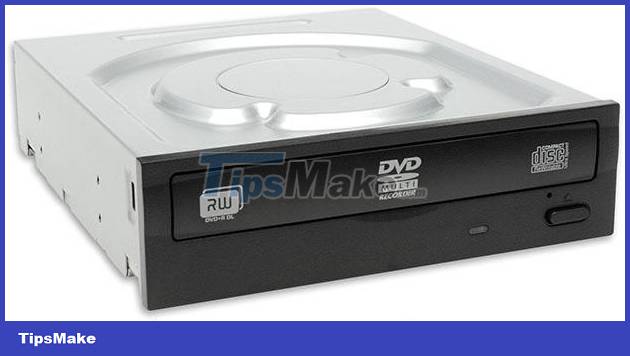Selection of drives for computers
Computers need a disk drive to store user programs and data, so a hard disk drive (HDD) is an indispensable device and is always built into the machine. In addition, sometimes users also need access to external data, so it is necessary to equip CD-ROM and DVD-ROM optical drives for computers.
Hard Disk Drive - Hard Disk Drive (HDD)
- A hard disk drive (HDD) is a data storage device that uses one or more rotating hard disks coated with magnetic layers. Hard disks are combined with magnetic heads that read and write data to the platter surfaces. Unlike memory (RAM), data stored on HDD will not be lost when the computer is turned off.
Parameters of HDD
 Hard Disk Drive 3.5 . HDD
Hard Disk Drive 3.5 . HDD
Shape and size of HDD
- HDD has many types, but the most common is the 3.5" (inch) type for desktop computers and 2.5" mainly for laptops.
- 3.5" and 2.5" are the size of the inner fork, the outside size will be larger and the thickness will also be different.
Connection standard of HDD
- The HDD is connected to the mainboard (Mainboard) using standard interface cables such as ATA (IDE), SATA (Serial ATA), USB (Universal Serial Bus) or SAS (Serial Attached SCSI) cables.
- The common connection standard of HDD today is SATA with SATA1, SATA2 and SATA3 standards.
Capacity of HDD
- The capacity of the HDD is its data storage capacity. The larger the HDD capacity, the more data can be stored. Units are GB (GigaByte) and TB (TeraByte), 1TB = 1024GB (usually even counted as 1000GB).
- A computer can attach many HDDs, the number of which will depend on the number of HDD jacks on the Mainboard.
Most computers usually have only one HDD but are divided into many parts (partitions, partitions) to form many different drives to help manage data, not many HDDs.
HDD speed
- The speed of the HDD is understood as the maximum data access speed. The speed of the HDD depends on its connection standard and the Mainboard.
- SATA1 (SATA 1.0) has a speed of 1.5 Gbit/s (150MB/s); SATA2 (SATA 2.0) has a speed of 3 Gbit/s (300MB/s); SATA3 (SATA 3.0) has a speed of 6 Gbit/s (600MB/s).
HDD rotation speed
- Typical HDD rpm is 5,400rpm, 7,200rpm, 10,000rpm or higher (rpm: Revolutions Per Minute, which is revolutions per minute).
- The rotation speed is not the data access speed of the HDD, but the higher the rotation speed, the faster the data access of the HDD. However, operating at high speed will cause the temperature of the HDD to increase.
HDD cache
- HDD is equipped with additional cache memory (Cache) to help speed up data access. This cache has a larger capacity, the faster the HDD's data access will be.
Warranty period of HDD
- Depending on each manufacturer, the HDD will have different modes and warranty periods, usually from 12 - 36 months.
- Hard drives are accepted for warranty when they have surface defects (Bad Sectors), mechanical and electronic damage but must be in a state of no signs of chip explosion (IC), falling, . and warranty stamps. expired, not torn. Some places accept warranty when burned, chip explosion .
How to choose an HDD for a computer?
- Please rely on the above parameters to know how to choose the right HDD for your needs.
- First of all, you need to check the Storage Devices parameter on the Mainboard to select the HDD with the appropriate connection standard.
- Next, you choose the HDD with the capacity to meet your needs. The operating system and normal application programs will take up no more than 100GB of HDD space.
- If you play games or use jobs that need to store a lot of data such as processing movies, photos, . then you should choose a HDD with a capacity of at least 500GB.
- In addition, with the current movement of watching Full HD movies on computers, you should also think about HDDs with a capacity greater than 1TB (about 1,000GB).
You can attach HDDs with speeds different from the connection speed of the Mainboard (standard SATA1 -> Standard SATA3 Mainboard or standard SATA3 -> SATA1 Standard Mainboard), but the speed of the HDD only works at the lowest level ( SATA1) only.
Some hard drives have a warranty period of 3 to 5 years, but retail stores reduce it to 2 years (24 months) or less, look for places with full warranties. from genuine.
Currently, new computers equipped with SSD (Solid State Drive) are much faster than HDD. This is a solution to help improve the slow speed of the hard drive compared to the overall speed of the system. Please see the article about How to choose an SSD solid-state drive.
Optical Drive CD-ROM Drive, DVD-ROM Drive
- Optical drive is a device used to access data stored on optical discs (Optical Compact Disc). Programs that install operating systems, applications, and games for computers are usually released as CD-ROM or DVD-ROM optical discs.
- Initially, computers were equipped with an optical drive, often called a CD-ROM (Compact Disc Read-Only Memory) drive, used to read CD-ROM optical discs, including music discs (Audio CDs), movie discs (VCDs), and CD-ROM drives. ) and data discs (Data CD, CD-ROM).
- Followed by the introduction of DVD standard optical discs with higher capacity, computers are also equipped with DVD-ROM optical disc readers (Digital Versatile Disc Read-Only Memory or Digital Video Disc Read-Only Memory). to read these DVD-ROM discs.
A DVD-ROM drive can read CDs, VCDs, and DVDs, but a CD-ROM drive can only read CDs and VCDs.
There is also a type of drive called a Blu-Ray Disk Drive (Blu-Ray Disk Drive) used to read Blu-Ray discs, this type of disc is used to store high quality (HD) movies. Blu-Ray drives are rarely used on computers.
CD/DVD-ROM drive parameters
 CD-ROM and DVD-ROM drives
CD-ROM and DVD-ROM drives
Shape and size of CD/DVD-ROM drive
- CD/DVD-ROM drives come in a 5.25" box shape and typically come in a white or black cover (or front) to match the color of the case.
Standard connection of CD/DVD-ROM drive
- CD/DVD-ROM drives have the same connection standards as hard drives, originally ATA (IDE) and now the faster SATA standard.
CD/DVD-ROM drive speed
- The speed of a CD/DVD-ROM drive is the maximum data transfer rate per second. The higher the speed, the faster the data retrieval.
- The speed of the CD/DVD-ROM drive is denoted by X, the X value of the CD-ROM is 150KB/s (KiloByte per second) and the X value of DVD is 1.38MB/s (MegaByte per second), 1MB=1024KB. So don't be surprised to see that the write speed on CD-ROM is 52X and DVD-ROM is "only" 16X.
* 1X CD-ROM drive with a maximum speed of 150KB/s; The CD-ROM drive marked 52X has a maximum speed of 7,8000KB/s (equivalent to about 8.2MB/s).
* 1X DVD-ROM drive with a maximum speed of 1.4MB/s; The 24X DVD-ROM drive has a maximum speed of 33.2MB/sec.
Function to burn and erase data on CDs, DVDs
- This function allows the CD/DVD drive to burn, erase and rewrite the data on the CD/DVD disc. Drives with this write/erase function will have the symbol RW (ReWrite).
- The write and erase speed of a CD/DVD RW drive is lower than the read speed.
Read and write discs
- This parameter indicates which discs the CD/DVD drive can read.
- If it is a CD/DVD RW drive, any discs can be burned, erased and rewritten.
Dual Layer Recording Technology - Dual Layer, Double Layer
- This technology allows DVD RW drives to burn onto DVD discs with 2 layers to double the storage capacity of DVD discs. These discs are labeled DVD-R DL or DVD+R DL.
Note that the optical disc with the symbol DL (Dual Layer, Double Layer) is a disc with 2 layers on one side, when reading / writing does not need to flip the disc. As for the type of disc 2 (Double Side) when reading / writing, the plate must be turned over.
 DVD+RW DL Drive - Burn/Erase/Rewrite supports 2-layer recording
DVD+RW DL Drive - Burn/Erase/Rewrite supports 2-layer recording
Guarantee
-
The warranty period for optical drives is usually 12 months, warranty is accepted when the condition is not read or pickled, mechanical damage . and the warranty stamp must be valid.
How to choose a CD/DVD-ROM drive for your computer
- Based on the parameters of the CD/DVD-ROM drive above, you can choose the right drive for your needs.
- Note to choose a CD/DVD drive with a connection standard that is compatible with your Mainboard and has a color that matches the color of the case.
- A computer can have multiple CD/DVD-ROM drives, the number of which depends on the number of connectors on the Mainboard.
- With the advent of memory cards, USB drives (USB Flash Drive) have high capacity, faster speeds and smaller sizes, so optical drives are rarely used.
Currently, due to low popularity, optical drives are not produced as much as before, so you will not have many choices. Except for the old CD-ROM drives, there are only DVD-RW drives on the market.
You should read it
- Know about bad sectors on your hard drive
- Computer hard drive is fast, why?
- How to identify hard drive failure, hard drive failure, bad hard drive on Windows
- 5 hard drives with the best reliability
- Dissection of hard drive components
- Notes when buying a computer hard drive
- How to check hard drive health in 3 ways
- 5 ways to check hard drive effectively to help periodically check the hard drive
May be interested
- Selecting a monitor for a computer
 guide to screen options for computers
guide to screen options for computers - Instructions to buy a laptop: Choose the appropriate specifications
 a high-speed cpu also means that the programs are run faster, but you also have to pay the price for it's lower battery life and also more expensive.
a high-speed cpu also means that the programs are run faster, but you also have to pay the price for it's lower battery life and also more expensive. - Working with Windows: shared drives
 there are three interesting ways to share a hard drive between mac and pc computers for general backup and storage.
there are three interesting ways to share a hard drive between mac and pc computers for general backup and storage. - Little known 5 parameters can slow down your computer
 when you intend to upgrade a computer or buy a new device, one of the top priorities is that the upgraded computer or new machine must run faster. there are many significant factors that will help improve performance such as high-speed processor, large ram or support for newer usb and wi-fi standards.
when you intend to upgrade a computer or buy a new device, one of the top priorities is that the upgraded computer or new machine must run faster. there are many significant factors that will help improve performance such as high-speed processor, large ram or support for newer usb and wi-fi standards. - Transfer data between computers
 many loyal people use their computers for many years. they can update a few components and solve maintenance-related issues to help the computer always run as best as possible. however, there will be times when you have no way to speed up or solve the problem with your old computer.
many loyal people use their computers for many years. they can update a few components and solve maintenance-related issues to help the computer always run as best as possible. however, there will be times when you have no way to speed up or solve the problem with your old computer. - Looking back on 60 years of miraculous development of hard drives today
 the hard drive was first founded in 1956 by the ibm corporation. from a capacity of 5 megabytes, the hard drive has now reached 60 tb, up 12 million times. the hard drive was born that opened a new page in the history of technology development at that time.
the hard drive was first founded in 1956 by the ibm corporation. from a capacity of 5 megabytes, the hard drive has now reached 60 tb, up 12 million times. the hard drive was born that opened a new page in the history of technology development at that time. - How to Use Selection Tools in Zoner Photo Studio X
 making a selection is very helpful in any photo program. zoner photo studio has a significantly lower learning curve than photoshop and it is much more affordable. selections, layers, and masks give you real editing power. this wikihow...
making a selection is very helpful in any photo program. zoner photo studio has a significantly lower learning curve than photoshop and it is much more affordable. selections, layers, and masks give you real editing power. this wikihow... - Guide to share drives and folders in Windows 7 to share data in LAN
 to save time sharing without the need for external devices or computers connected to the internet, you can quickly share folders to many other computers on the same lan.
to save time sharing without the need for external devices or computers connected to the internet, you can quickly share folders to many other computers on the same lan. - What is a NAS hard drive? What is a Surveillance Hard Drive?
 capacity is not the only thing that distinguishes one hard drive from another. there are many types of hard drives on the market. in today's article, tipsmake.com will help readers distinguish between 2 types of hard drives. that is nas drive and surveillance drive.
capacity is not the only thing that distinguishes one hard drive from another. there are many types of hard drives on the market. in today's article, tipsmake.com will help readers distinguish between 2 types of hard drives. that is nas drive and surveillance drive. - Choosing a case and a power supply for a computer
 guide to choosing the case and power supply for computers
guide to choosing the case and power supply for computers












 Choosing SSD hard drives for computers
Choosing SSD hard drives for computers How to install Webcam for computer
How to install Webcam for computer How to recognize the status of the computer through the sound
How to recognize the status of the computer through the sound How to set up a computer to boot from CD-ROM
How to set up a computer to boot from CD-ROM Instructions on how to remove the cooling fan of the standard CPU LGA775
Instructions on how to remove the cooling fan of the standard CPU LGA775 Instructions on how to assemble a cooling fan for standard CPU LGA775
Instructions on how to assemble a cooling fan for standard CPU LGA775